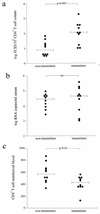Infectious cellular load in human immunodeficiency virus type 1 (HIV-1)-infected individuals and susceptibility of peripheral blood mononuclear cells from their exposed partners to non-syncytium-inducing HIV-1 as major determinants for HIV-1 transmission in homosexual couples
- PMID: 9420218
- PMCID: PMC109367
- DOI: 10.1128/JVI.72.1.218-224.1998
Infectious cellular load in human immunodeficiency virus type 1 (HIV-1)-infected individuals and susceptibility of peripheral blood mononuclear cells from their exposed partners to non-syncytium-inducing HIV-1 as major determinants for HIV-1 transmission in homosexual couples
Abstract
To study risk factors for homosexual transmission of human immunodeficiency virus type 1 (HIV-1), we compared 10 monogamous homosexual couples between whom transmission of HIV-1 had occurred with 10 monogamous homosexual couples between whom HIV-1 transmission had not occurred despite high-risk sexual behavior. In the group of individuals who did not transmit virus, peripheral cellular infectious load was lower and the CD4+ T-cell counts were higher than in the group of transmitters. HIV-1 RNA levels in serum did not differ between transmitters and nontransmitters. Compared with peripheral blood mononuclear cells (PBMC) from normal healthy blood donors, 8 of 10 nonrecipients and only 3 of 8 recipients had PBMC with reduced susceptibility to in vitro infection with non-syncytium-inducing (NSI) HIV-1 variants isolated from either their respective partners or an unrelated individual. No difference in susceptibility was observed for infection with a syncytium-inducing variant. Among the individuals who had PBMC with reduced susceptibility, five nonrecipients and one recipient had PBMC that were equally or even less susceptible to NSI variants than PBMC that had low susceptibility and that were derived from healthy blood donors that were heterozygous for a 32-bp deletion in the CCR5 gene (CCR5 delta32). Three of these individuals (all nonrecipients) had a CCR5 delta32 heterozygous genotype themselves, confirming an association between low susceptibility to NSI variants and CCR5 delta32 heterozygosity. All three recipients with less susceptible PBMC had partners with a high infectious cellular load; inversely, both nonrecipients with normally susceptible PBMC had partners with a very low infectious cellular load. These results suggest that a combination of susceptibility of target cells and inoculum size upon homosexual exposure largely determines whether HIV-1 infection is established.
Figures



Similar articles
-
MT-2 tropism and CCR-5 genotype strongly influence disease progression in HIV-1-infected individuals.AIDS. 1998 May 7;12(7):729-36. doi: 10.1097/00002030-199807000-00009. AIDS. 1998. PMID: 9619804
-
The HIV type 1 coreceptor CCR5 and its role in viral transmission and disease progression.AIDS Res Hum Retroviruses. 1998 Apr;14 Suppl 1:S89-92. AIDS Res Hum Retroviruses. 1998. PMID: 9581891
-
Association between CCR5 genotype and the clinical course of HIV-1 infection.Ann Intern Med. 1997 Nov 15;127(10):882-90. doi: 10.7326/0003-4819-127-10-199711150-00004. Ann Intern Med. 1997. PMID: 9382366
-
HIV-1 infection in individuals with the CCR5-Delta32/Delta32 genotype: acquisition of syncytium-inducing virus at seroconversion.J Acquir Immune Defic Syndr. 2002 Mar 1;29(3):307-13. doi: 10.1097/00126334-200203010-00013. J Acquir Immune Defic Syndr. 2002. PMID: 11873082 Review.
-
Molecular biological assessment methods and understanding the course of the HIV infection.APMIS Suppl. 2003;(114):1-37. APMIS Suppl. 2003. PMID: 14626050 Review.
Cited by
-
Two amino acid substitutions within the first external loop of CCR5 induce human immunodeficiency virus-blocking antibodies in mice and chickens.J Virol. 2008 Apr;82(8):4125-34. doi: 10.1128/JVI.02232-07. Epub 2008 Feb 6. J Virol. 2008. PMID: 18256149 Free PMC article.
-
Selective impact of HIV disease progression on the innate immune system in the human female reproductive tract.PLoS One. 2012;7(6):e38100. doi: 10.1371/journal.pone.0038100. Epub 2012 Jun 4. PLoS One. 2012. PMID: 22675510 Free PMC article.
-
Preinfection human immunodeficiency virus (HIV)-specific cytotoxic T lymphocytes failed to prevent HIV type 1 infection from strains genetically unrelated to viruses in long-term exposed partners.J Virol. 2009 Oct;83(20):10821-9. doi: 10.1128/JVI.00839-09. Epub 2009 Aug 12. J Virol. 2009. PMID: 19706711 Free PMC article.
-
Impaired viral entry cannot explain reduced CD4+ T cell susceptibility to HIV type 1 in certain highly exposed individuals.AIDS Res Hum Retroviruses. 2008 Nov;24(11):1415-27. doi: 10.1089/aid.2007.0256. AIDS Res Hum Retroviruses. 2008. PMID: 19000021 Free PMC article.
-
Reduced CD4 T cell activation and in vitro susceptibility to HIV-1 infection in exposed uninfected Central Africans.Retrovirology. 2006 Jun 22;3:35. doi: 10.1186/1742-4690-3-35. Retrovirology. 2006. PMID: 16792805 Free PMC article.
References
-
- Arthur L O, Bess J W, Jr, Showder II R C, Benveniste R E, Mann D L, Chermann J C, Henderson L E. Cellular proteins bound to immunodeficiency viruses: implications for pathogenesis and vaccines. Science. 1992;258:1935–1938. - PubMed
-
- Belec L, Georges A J, Steenman G, Martin P M V. Antibodies to human immunodeficiency virus in the semen of heterosexual men. J Infect Dis. 1989;159:324–327. - PubMed
-
- Biti R, French R, Young J, Bennetts B, Stewart G, Liang T. HIV-1 infection in an individual homozygous for the CCR5 deletion allele. Nature Med. 1997;3:252–253. - PubMed
-
- Blaak, H., F. De Wolf, A. B. Van’t Wout, N. G. Pakker, M. Bakker, J. Goudsmit, and H. Schuitemaker. Viral load in HIV-1 infection: correlation between viral RNA levels in serum and frequency of productively infected cells in peripheral blood. J. Infect. Dis., in press. - PubMed
Publication types
MeSH terms
Substances
LinkOut - more resources
Full Text Sources
Medical
Research Materials

